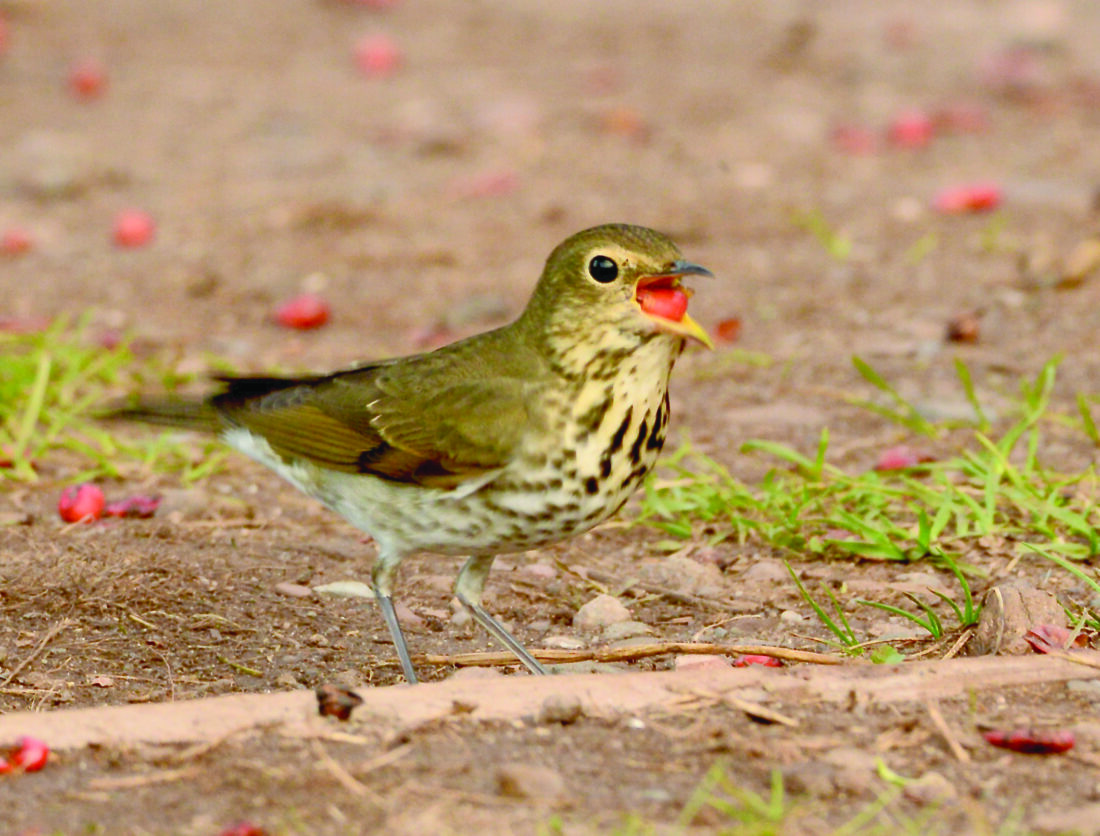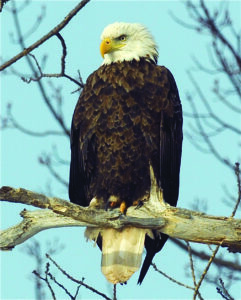What’s Flying: A blissful mix of beauty, wonder and melancholy

A Swainson's thrush sings. (Scot Stewart photo)
“Nowadays, people are so jeezled up. If they took some chamomile tea and spent more time rocking on the porch in the evening listening to the liquid song of the hermit thrush, they might enjoy life more.” – Tasha Tudor
Recent days have seen thousands of thrushes pass through the Upper Peninsula. A majority have, unfortunately, silently passed intent on making it to their winter ranges. Most of the thrushes seen have come south from Canada and possibly Alaska, with two species, the more common Swainson’s thrushes headed for the highlands of Central and South America and gray-cheeked thrushes headed to northern South America.
Some have stopped to refuel as was recently witnessed at Sunset Point at Presque Isle in Marquette. There is a single mountain ash tree at the edge of the parking lot there loaded with bunches of ripening orange fruit clusters. The fruit was quickly fund by the thrushes and as many as 50 thrushes were often seen darting in and out of the tree to feed. It took several days for the birds to clean out the tree with a number coming back to feed on fruits been pulled from the tree but dropped.
Fall migration always brings a blissful mix of beauty, wonder and melancholy. Waves of migrants can offer trees full of birds, especially around the days with weather unfavorable for flying. The last 12 days have proven there are a lot of birds migrating through Marquette. Birders have watched their passing on several mornings at Presque Isle during their morning flight, recorded and posted their numbers on eBird.
The numbers have been impressive. Over the course of five mornings birders watched birds at Presque Isle Park and counted them and others as they and as they flew over on their way south over periods of several hours. The number of species has topped out at 62 so far, with that number coming just last Wednesday. The number of individual birds that day topped 4400, with three-quarters of them warblers. During these days, flocks of different species have been observed. Some days sparrows and warblers have made up the larger numbers of species, thrushes, and red-breasted nuthatches on others. The most recent flight saw a great mix including flycatchers, vireos, kinglets, warblers, sparrows and thrushes. A big push of dark-eye juncos and a juvenile red-headed woodpecker were notable additions to the birds seen.

SCOT STEWART
Shorebird migration has definitely slowed. Just a few semipalmated plovers have been seen in Marquette this past week and a buff-breasted sandpiper was found on the Lower Harbor breakwall. At Whitefish Point in Chippewa County American golden-plovers are beginning to move through and few sanderlings are being seen too.
Fall is also the time many of the area’s ant colonies send new winged kings and queens, called alates, out of their hills and into their nuptial flights. They will fly off to sites away from their home hills, find a mate, tear off their wings and begin excavating a tunnel to start a new colony. These winged members will fly off often after a rain that has left the soil soft and ready receive them. While this is an important event for the ants, it is also important to a number of species of birds too.
When the alates leave their hills, to improve the chances of at least a few at each hill, they leave in large numbers called swarms. Lots leave in a short time. The activity attracts the attention of woodpeckers, especially northern flickers and larger pileated woodpeckers. At Presque Isle Park in Marquette there are several families of pileated woodpeckers and perhaps because of the park status, they have grown accustomed to people. They have often been seen foraging close to park visitors, especially in near the bandshell area and the playground.
Last week, following some cool rainy days ant swarming began in several areas in Marquette, including at Presque Isle. Last Friday a male pileated woodpecker and a younger male were followed as they worked across the open area above the Gazebo for more than 45 minutes. They worked on ant hills in separate areas most of the time but did briefly catch emerging ants near each other and on one occasion the adult fed the younger male. Later that evening and again the following afternoon two were seen near the ice cream stand also feeding on the ground.
Because the ants have wings and do fly considerable distances as they fly and are carried upward by the wind. Swarms quickly draw the attention of ring-billed gulls in Marquette and on good days small flocks circle over the areas where the ants are and look like flycatchers snatching the ants on the wing. Much like the huge numbers of seeds produced by many plants each season, the explosion of these ants helps ensure some will make it and maintain local populations of the species. If a few hatched here and there they might all be scooped up by birds and other insect eaters.
- A Swainson’s thrush sings. (Scot Stewart photo)
- SCOT STEWART
The melancholy part of this part of the month is knowing many of the summer birds responsible for the songs and color of summer are on their way south for the winter. As they depart, the color of autumn leaves will replace much of the color lost for a brief time, but most all of it will be eventually washed out by the white of winter. There is still time to catch the end of the birds still in the area, early autumn leaves, and tons of gorgeous mushrooms and slime molds currently bedecking the woods.




